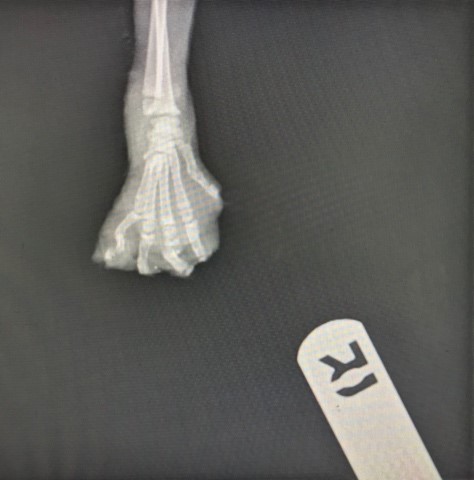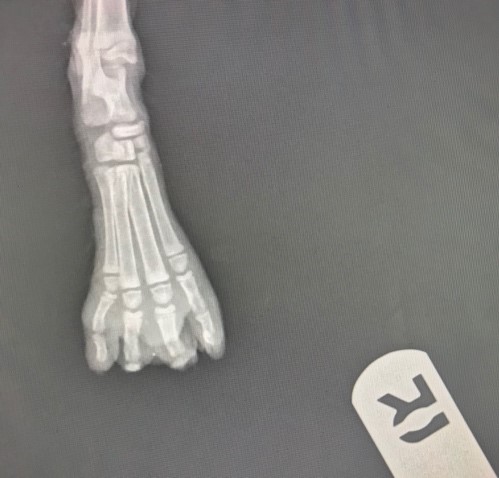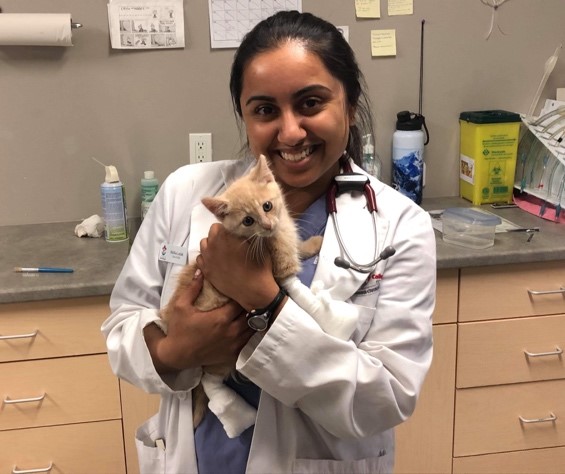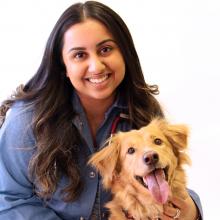My first few weeks of my externship at Aylmer Veterinary Clinic have been off to a great start! I’ve been getting lots of hands-on opportunities doing spays and neuters, practicing blood draws, putting in intravenous catheters, and performing physical exams. It was very overwhelming to start appointments and get the hang of things at first, but I’ve settled well into the routine of things. Some days are quite challenging, whereas others I feel like I know what I’m doing, which I’m starting to learn is all part of the job! It is totally normal to feel this way as a veterinary student while I’m trying to apply things we’ve learned in classes to real life.
This week, a two-month old kitten came to the clinic with degloving injuries on two of its legs (degloving is when an extensive amount of skin is torn away). A client found him on the road near Aylmer and brought him to the clinic to seek veterinary care. Aside from the wounds, he was otherwise a healthy kitten. We cleaned and decontaminated his wounds temporarily at first in order to take radiographs of his limbs to assess the severity of his injuries. As we looked at the radiographs, we noticed that he was missing the third digit, also called the third phalanx or P3, on most of his toes. The third phalanx in cats is attached to the claws, making him essentially declawed on the two injured limbs. He had two remaining claws on his right front limb and one remaining claw on his right hind limb, which you can see in the radiographs below. The rest of the bones in his limbs appeared to be normal otherwise. He may have gotten this injury by getting the right side of his body caught in something as his injuries were only on his right front and back limbs, but we can’t say for sure.


We began treating and managing his wounds by using a layer of sugar and Vaseline as the contact layer with his wounds. Sugar helps reduce tissue swelling and reduces bacterial contamination so that the wound doesn’t get a bacterial infection. The sugar and Vaseline were secured with a non-stick bandage called a Telfa pad, and wrapped with gauze and a bandage wrap to  secure it all in place and prevent it from sliding off. It took the kitten some time to get used to the bandages since they were slightly bulky, but he was able to walk with them on within a week! As the wound continued to heal, we transitioned to soaking his paws in an Epsom salt and warm water mixture to reduce the swelling and applied a topical antibacterial to the site to prevent them from getting infected. The kitten was receiving these bandage changes daily, and it was great to see the progress he was making every day. Fast forward two weeks, and the skin layer is almost completely closed over the areas and he is able to walk much better. The toes that are unable to fully heal will likely form a larger stub of tissue surrounded by skin, which he has already adapted to walking with. Because of his injuries, we decided to name him Nubbins!
secure it all in place and prevent it from sliding off. It took the kitten some time to get used to the bandages since they were slightly bulky, but he was able to walk with them on within a week! As the wound continued to heal, we transitioned to soaking his paws in an Epsom salt and warm water mixture to reduce the swelling and applied a topical antibacterial to the site to prevent them from getting infected. The kitten was receiving these bandage changes daily, and it was great to see the progress he was making every day. Fast forward two weeks, and the skin layer is almost completely closed over the areas and he is able to walk much better. The toes that are unable to fully heal will likely form a larger stub of tissue surrounded by skin, which he has already adapted to walking with. Because of his injuries, we decided to name him Nubbins!
To the right is a picture of me and Nubbins after one of his daily bandage changes. He was adopted by one of the high school co-op students at the clinic and will go home once he’s all healed up.
Thanks for reading!
